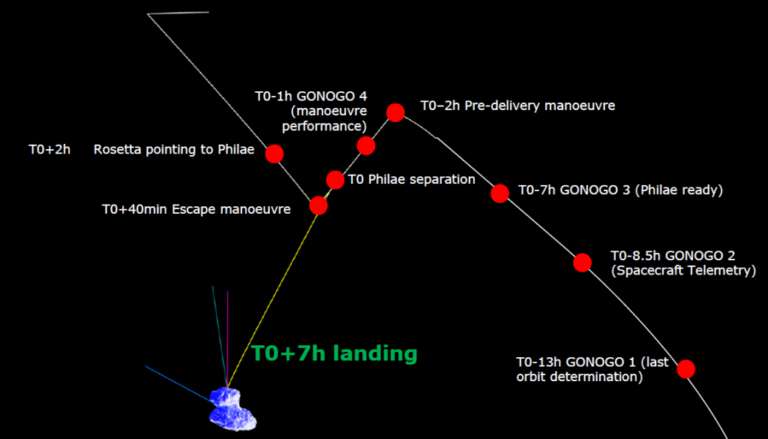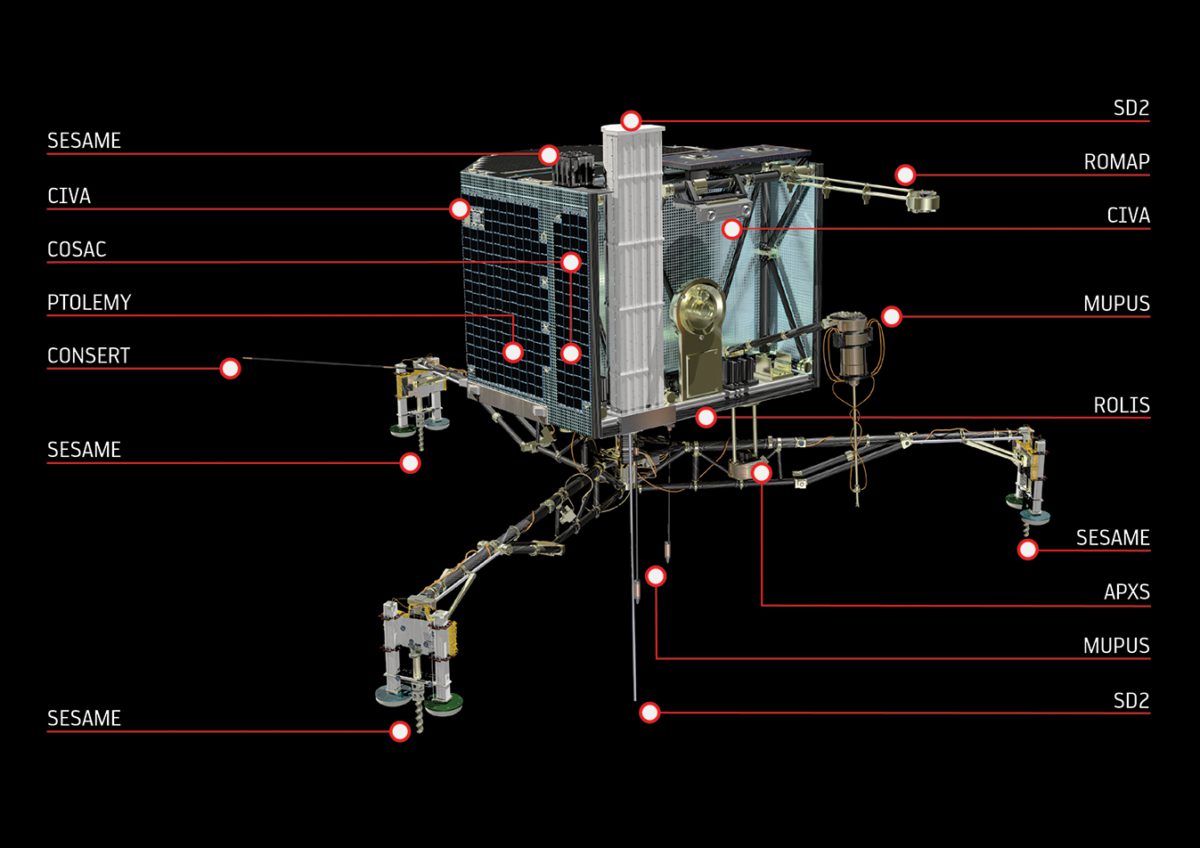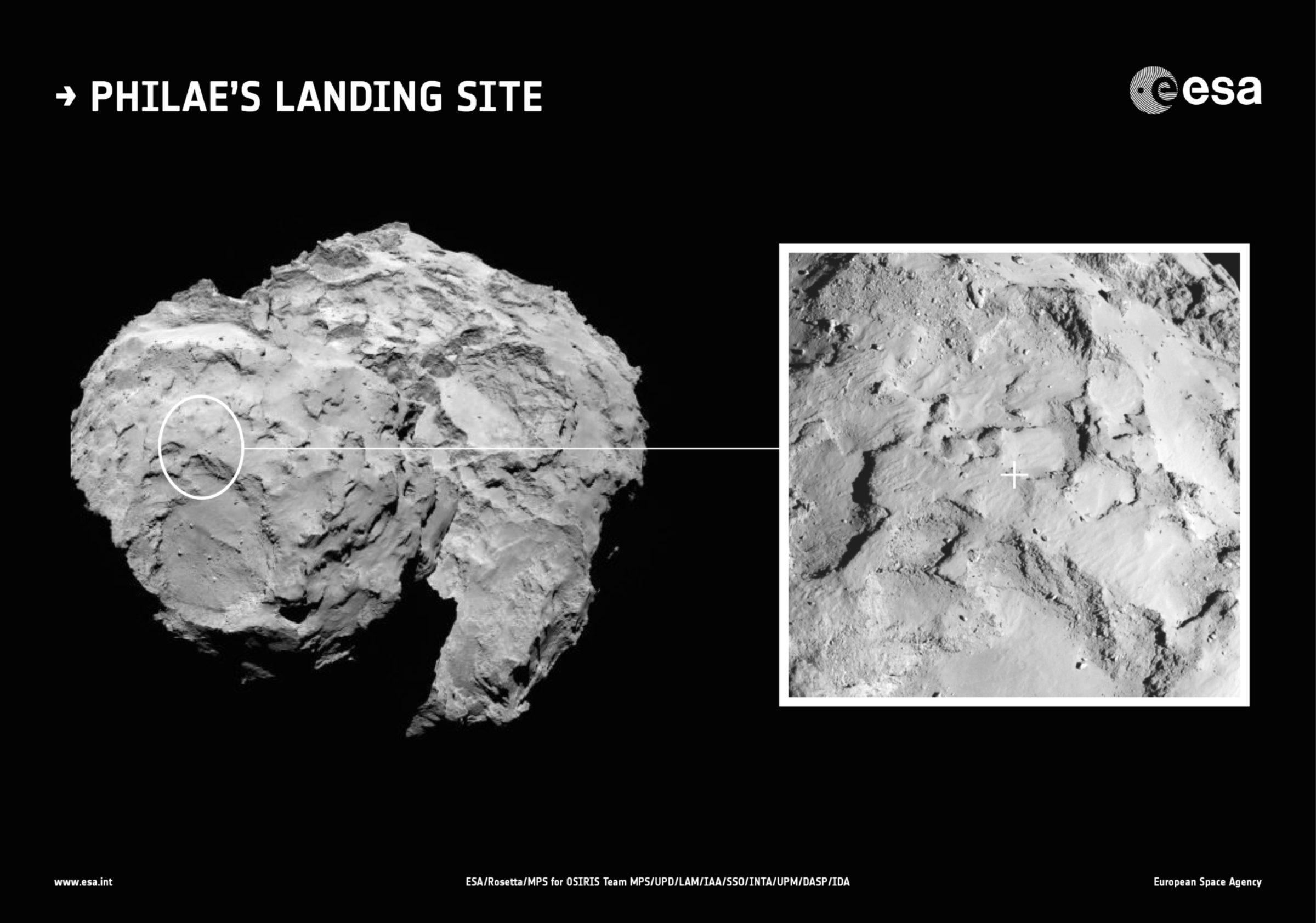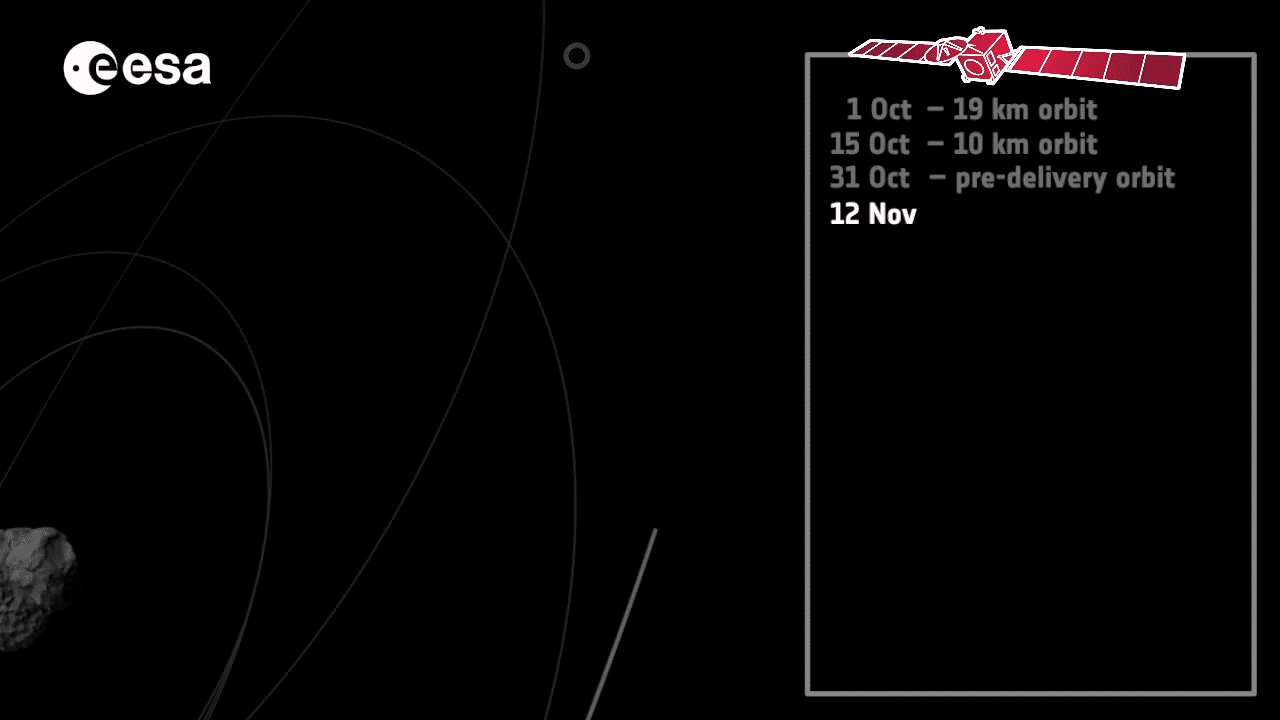Emily Lakdawalla • Nov 05, 2014
Philae landing preview: What to expect on landing day
The timeline is up-to-date as of November 12 at 07:30 UTC.
Ten years. That's how long it took Rosetta to get from Earth to comet 67P/Churyumov-Gerasimenko from its launch on March 2, 2004, to the beginning of its first orbit on August 6, 2014. For the Philae lander, bolted to the side of Rosetta, the journey has been slightly longer, and it's not quite over yet.
Philae has warmed up its science instruments and has even taken a couple of amazing photos of the comet with Rosetta's solar panel in the foreground, but the lander doesn't really begin to get to work until November 12 at 8:35 UT, when it will finally separate from the orbiter. Seven hours later, it will arrive at the surface of the comet. Hopefully, Philae will survive the landing, and begin to return data.
All next week, I'll be in Darmstadt, Germany, at the European Space Operations Centre (ESOC), to witness the historic attempt at landing on a comet. I'm not going to lie to you: I'm going to be terrified about Philae's survival until I see ESA engineers leaping from their seats and cheering. To be clear, I have no specific doubts about the spacecraft or its designers. It's just that we have never landed on anything like a comet before. We don't really know what the surface of a comet is like -- is it a hard, crusty shell of rocky material? A diaphanously fluffy, almost cloud-like layer of highly porous dust? Gravelly? Crunchy? Crystalline? Powdery? Sandpapery? Slippery? Who knows? The last time we landed on a surface that we knew so little about was when ESA landed Huygens on Titan in 2004. But Huygens did almost all of its science on the way down, returning all its data to the Cassini orbiter in real time, so it didn't matter whether Huygens survived its arrival on Titan's surface. In contrast, almost all of Philae's science will not come until after a successful landing. It's going to be terrifying. But I wouldn't miss it for the world.
What will we know, when? Below is a timeline of Philae events, and a brief summary of what Philae intends to do. Media-related events are highlighted yellow; mission control events in orange; and the major separation and landing events in red, most of it taken from this timeline released November 7 by ESA (PDF).
| Time at spacecraft | Time on Earth | ||||
|---|---|---|---|---|---|
| Event | relative | SCET, UT | CET | UTC | PST |
| Rosetta Google Hangout | -- | -- | Nov 7 16:00 | Nov 7 15:00 | Nov 7 07:00 |
| ESOC media update (ESA TV) | -- | -- | Nov 10 15:00 | Nov 10 14:00 | Nov 10 06:00 |
| ESOC media update (ESA TV) | -- | -- | Nov 11 11:00 | Nov 11 10:00 | Nov 11 02:00 |
| Lander switch-on | -14h 30m | Nov 11 18:05 | 19:33 | 18:33 | 10:33 |
| Lander batteries and compartment heating; ADS tank opening | -13h 58m | 18:37 | 20:05 | 19:05 | 11:05 |
| Lander primary battery condition start | -13h 38m | 18:57 | 20:25 | 19:25 | 11:25 |
| 24-hour ESA #CometLanding Livestream begins | -- | -- | 20:00 | 19:00 | 11:00 |
| ESOC media update (ESA TV) | -- | -- | 20:00 | 19:00 | 11:00 |
| Go/no-go decision 1: ESOC Flight Dynamics confirms Rosetta on correct trajectory | -- | -- | 20:30 | 19:30 | 11:30 |
| Rosetta starts slew to pre-delivery attitude (expected loss of signal) | -13h | 19:34 | 21:03 | 20:03 | 12:03 |
| End of Rosetta slew | -12h 20m | 20:14 | 21:43 | 20:43 | 12:43 |
| Start lander flywheel operation | -12h 11m | 20:24 | 21:52 | 20:52 | 12:52 |
| Go/no-go decision 2: Confirm lander sequence and Rosetta ready for separation | -- | -- | Nov 12 01:00 | Nov 12 00:00 | 16:00 |
| Lander generates final telemetry for separation decision | -8h | Nov 12 00:35 | 02:03 | 01:03 | 17:03 |
| Go/no-go decision 3: Confirm Philae ready for landing (This decision was delayed about an hour due to problem with cold-gas jet system on lander) | -- | -- | 03:35 | 02:35 | 18:35 |
| Start switching lander instruments on; ROMAP is first | -5h | 03:35 | 05:03 | 04:03 | 20:03 |
| Rosetta start executing on-board commands for delivery operations | -4h 35m | 04:00 | 05:28 | 04:28 | 20:28 |
| Start heating lander batteries to separation temperature | -4h 29m | 04:06 | 05:34 | 04:34 | 20:34 |
| Rosetta pre-delivery maneuver (lining up for separation) | -2h 33m | 06:01 | 07:30 | 06:30 | 22:30 |
| Go/no-go decision 4: proceed for landing | -- | -- | 08:05 | 07:05 | 23:05 |
| Switch on MUPUS | -1h 14m | 07:21 | 08:49 | 07:49 | 23:49 |
| Start MUPUS operation; switch on CIVA and ROLIS imagers | -1h 11m | 07:24 | 08:52 | 07:52 | 23:52 |
| Start CIVA and ROLIS; switch on SESAME dust sensor | -1h 8m | 07:27 | 08:55 | 07:55 | 23:55 |
| Start SESAME | 0h 59m | 07:36 | 09:04 | 08:04 | Nov 12 00:04 |
| Turn on separation mechanical systems | 0h 17m | 08:18 | 09:46 | 08:46 | 00:46 |
| Start CONSERT on orbiter | 0h 14m | 08:21 | 09:49 | 08:49 | 00:49 |
| Start CONSERT on lander | 0h 13m | 08:22 | 09:50 | 08:50 | 00:50 |
| Start internal automated sequence to prepare for landing | 0h 11m | 08:23 | 09:51 | 08:51 | 00:51 |
| Lander to internal battery power | 0h 10m | 08:25 | 09:53 | 08:53 | 00:53 |
| Time at spacecraft | Time on Earth | ||||
| Event | relative | SCET, UT | CET | UTC | PST |
| Lander separation, 94-second window, separation at 18 cm/s, 22.5 km from comet. Separation, Descent, and Landing phase begins | +0h | 08:35 | 10:03 | 09:03 | 01:03 |
| Lander CIVA camera photographs orbiter (FAREWELL1) | +0h | 08:35 | 10:04 | 09:04 | 01:04 |
| Lander CIVA camera photographs orbiter (FAREWELL2) | +0h 2m | 08:37 | 10:06 | 09:06 | 01:06 |
| Lander/orbiter separation distance 100m; earliest landing gear and ROMAP boom deployment | +0h 8m | 08:43 | 10:12 | 09:12 | 01:12 |
| Lander begins rotation of 14 degrees to stable landing orientation | +0h 22m | 08:57 | 10:25 | 09:25 | 01:25 |
| Rosetta divert maneuver; loss of signal due to slew | +0h 40m | 09:15 | 10:43 | 09:43 | 01:43 |
| Lander completes post-separation activities | +0h 43m | 09:18 | 10:47 | 09:47 | 01:47 |
| Acquisition of signal from lander | +1h 50m | 10:25 | 11:53 | 10:53 | 02:53 |
| Start of downlink of stored data, including CIVA "farewell" image | +2h 55m | 11:31 | 13:00 | 12:00 | 04:00 |
| Earliest possible release of NavCam and/or CIVA "farewell" images | -- | -- | 13:40 | 12:40 | 04:40 |
| NASA TV coverage begins | -- | -- | 15:00 | 14:00 | 06:00 |
| Start CIVA and ROLIS; switch on lander anchor | +5h 55m | 14:30 | 15:58 | 14:58 | 06:58 |
| Start imaging landing site; switch on active descent system (cold jets that will push lander against surface) | +5h 58m | 14:33 | 16:01 | 15:01 | 07:01 |
| ROLIS begins imaging | +6h 3m | 14:38 | 16:07 | 15:07 | 07:07 |
| Lander completes pre-touchdown operations | +6h 13m | 14:48 | 16:17 | 15:17 | 07:17 |
| Start of lander touchdown window | +6h 18m | 14:54 | 16:22 | 15:22 | 07:22 |
| Time at spacecraft | Time on Earth | ||||
| Event | relative | SCET, UT | CET | UTC | PST |
| Expected Landing (time approx). Thruster fires for 15 seconds; harpoons fire; flywheel turns off. Note: times for subsequent events are relative to actual landing time. | +7h | 15:35 | 17:03 | 16:03 | 08:03 |
| CIVA panoramic imaging (transmitted to Rosetta immediately) | Landing +0h 3m | 15:38 | 17:07 | 16:07 | 08:07 |
| Ptolemy and COSAC begin science; descent data transmitted to Rosetta | Landing +0h 3m | 15:38 | 17:07 | 16:07 | 08:07 |
| NASA TV coverage ends | -- | -- | 17:30 | 16:30 | 08:30 |
| Lander completes separation, descent, and landing phase, uploads data | Landing +0h 36m | 16:11 | 17:39 | 16:39 | 08:39 |
| Earliest possible presentation of first images | -- | -- | 18:00 | 17:00 | 09:00 |
| First science sequence begins | Landing +1h 45m | 17:20 | 18:49 | 17:49 | 09:49 |
| 24-hour ESA #CometLanding Livestream ends | -- | -- | 19:00 | 18:00 | 10:00 |
| End of first lander/orbiter communication window | Landing +2h 59m | 18:34 | 20:03 | 19:03 | 11:03 |
| ESOC media update (ESA TV) | -- | -- | Nov 13 14:00 | Nov 13 13:00 | Nov 13 05:00 |
| First science sequence ends | Landing +65h | Nov 15 08:35 | Nov 15 10:03 | Nov 15 09:03 | Nov 15 01:03 |
A note on timing. Events are shown in both spacecraft event time (SCET) -- the time on the spacecraft's clock, which will correspond to timestamps on images and data -- and in Earth time (Universal, Central European, and Pacific time zones). On the day of landing, the comet will be about 510 million kilometers from Earth, so one-way light time between the spacecraft and Earth is just shy of half an hour (28 minutes 20 seconds, to be exact). For events that will take place aboard spacecraft, like rocket maneuvers, I take spacecraft time from the ESA published timeline and add one-way light time to get Earth time, because that is the time on Earth that we should hear that those events happen. The first version of this timeline is almost certain to contain some errors; I will update this post to correct those and add more information as I find it. The graphical timeline below, which came from ESA, is actually a mix of spacecraft and Earth event times, confusingly. Other sources of timeline information include the ESA TV website and the ESA invitation to media.

Philae's instruments: A brief guide
Science instruments come in two types: remote sensing (which detect things from a distance) and in-situ (which must be in contact with what they measure). Philae can use its remote sensing instruments during descent, but the in-situ instruments don't get to operate until after landing.
- Remote sensing instruments include the CIVA and ROLIS imagers and CONSERT radar sounder. CIVA's 6 cameras can produce panoramic images of the comet's surface; the side-looking ones have produced Rosetta's iconic self-portraits. ROLIS is intended to provide context images for in-situ measurements; it will take photos during descent. CONSERT has components on both orbiter and lander; it transmits radio waves from orbiter to the lander, sometimes through the comet itself.
- Because magnetic fields and plasma exist in the space around a comet, not just on the surface, one in-situ instrument will be able to operate during descent: the Rosetta Lander Magnetometer and Plasma Monitor (ROMAP). ROMAP studies the magnetic field and interaction between comet and solar wind.
- In-situ instruments include the Alpha Particle X-Ray Spectrometer (APXS), the Cometary Sampling and Composition Experiment (COSAC), Multi-Purpose Sensors for Surface and Subsurface Science (MUPUS), Ptolemy, and the Surface Electrical Sounding and Acoustic Monitoring Experiments (SESAME), which will only be used after landing. APXS measures elemental composition. COSAC and Ptolemy are evolved-gas analyzers, which can determine molecular and isotopic composition from samples delivered to it by Philae's drill and sampling mechanism (SD2). MUPUS and SESAME are suites of sensors that will measure the physical properties of the comet's surface.

APXS: Alpha Particle X-ray Spectrometer, for studying elemental composition
CIVA: Comet Nucleus Infrared and Visible Analyser, six black-and-white cameras for panoramic imaging
CONSERT: COmet Nucleus Sounding Experiment by Radiowave Transmission, for studying comet interior
COSAC: The COmetary SAmpling and Composition, an evolved gas analyzer for identifying organic molecules
Ptolemy: an evolved gas analyzer for measuring isotopes of light elements
MUPUS: MUlti-PUrpose Sensors for Surface and Sub-Surface Science, for studying comet physical properties
ROLIS: Rosetta Lander Imaging System, will provide context images of landing site
ROMAP: Rosetta Lander Magnetometer and Plasma Monitor, for studying the magnetic field and plasma environment of the comet
SD2: Sampling, drilling and distribution subsystem, can drill to 23 centimeters depth
SESAME: Surface Electric Sounding and Acoustic Monitoring Experiment, for studying comet physical propertiesImage: ESA / ATG medialab
Setting Up for Landing
Philae will land at a site named "Agilkia" for an island in the Nile river in a public contest. Agilkia is on the smaller of the comet's two lobes, though not on the end; hopefully CONSERT will be able to see completely through the small lobe when Rosetta is in the right position.

To deliver Philae to Agilkia, Rosetta fires rockets to put it on a collision course with the comet. Back on Earth, mission controllers will check that the maneuver was successful and on target before delivering the "go for separation" command. With a half-hour one-way light time between Rosetta and Earth, this cycle will take an hour to complete. Two hours after the pre-delivery maneuver, Rosetta will release Philae. Forty minutes after that, Rosetta will perform a divert maneuver, allowing it to continue onward to a relay orbit around the comet, from which Rosetta can receive Philae transmissions and perform the CONSERT experiment.
Here is a Youtube video that shows the crazy maneuvering of Rosetta for landing and relay operations in great detail. I've pulled out the frames right around the landing so that you can see how the motion of Rosetta and rotation of the comet fit together to deliver Philae to the landing site.

Separation, Descent, and Landing
Separation, Descent, and Landing (SDL) events are described in detail on the Rosetta blog.
Separation
The lander will be pushed from the orbiter at a commanded, precise speed. If the commanded deploy does not succeed, a backup spring can push the lander off at a speed of 18 centimeters per second. CIVA will take a "farewell" image of the orbiter, which should be returned during the descent. Hopefully Rosetta's NavCam will capture the return image, of Philae departing.
Descent
It will take Philae 7 hours to free-fall the 22.5 kilometers to Churyumov-Gerasimenko's surface. Within an hour of separation, Philae will establish radio contact with Rosetta, unfold its three-legged landing gear, deploy the CONSERT radio antenna, deploy the boom holding the ROLIS camera, and begin taking photos with ROLIS.
Forty minutes after separation, Rosetta will perform a divert maneuver. Two hours after separation, Rosetta will turn to watch Philae drift toward the comet.
Throughout its descent, Philae will be actively gathering data. ROLIS will shoot descent images. COSAC, Ptolemy, and SESAME will attempt to sample gas and dust around the comet. ROMAP and SESAME will measure magnetic fields and plasma. CONSERT will measure the separation between lander and orbiter, and also try to actively sense the surface of the comet.
A little of the descent data will be transmitted to Rosetta during the descent, so regardless of what happens to Philae when it contacts the comet, there will be some science returned. Descent data may include the CIVA farewell image and CONSERT data on the range from orbiter to lander with respect to time, among other information. (Ref)
Landing
Philae's legs are designed to damp out the forces of a hard landing to reduce the lander's chance of bouncing. When Philae touches down, it will fire two harpoons to attach it firmly to the comet's surface. A thruster on top of the lander fires at the same time as the harpoons, keeping the lander on the ground. Ice screws also deploy from the three lander feet.
Upon landing, the first science activities will be CIVA panoramic imaging, MUPUS acceleration measurements, and SESAME elastic properties measurements. The descent data and these first images will be returned as soon as possible so that mission engineers can determine the orientation of the lander, and then command it to rotate it to best illuminate its solar panels and optimize the positions of the lander instruments. Mission engineers will also use these early data to calculate tables describing when the orbiter will be visible from the lander (for communication) and when the ground will be illuminated. (Ref)
If the comet turns out to be very soft (with a compressive strength less than 2 kPa, similar to lightly compacted snow), the lander could sink in up to its baseplate, which would prevent it from rotating. The lander would only sink farther if the compressive strength were less than 100 Pa (similar to powder snow). (Ref 1, ref 2)
The first science sequence lasts five days and can be performed entirely under battery power; with solar power, the lander could survive and continue doing science for much longer. For more post-landing plans, read the Rosetta blog.
Whatever happens on landing day, I'll be there to report it! Stay tuned to this blog, to my Twitter feed, and to my list of official Rosetta and Philae tweeters for news.
Video: Philae touchdown! Visualisation of the deployment of the Philae lander from Rosetta at comet 67P/Churyumov-Gerasimenko in November 2014. Rosetta will come to within 2.5 km of the comet’s surface to deploy Philae, which will then take around 2 hours to reach the surface.Video: ESA / ATG medialab
Let’s Go Beyond The Horizon
Every success in space exploration is the result of the community of space enthusiasts, like you, who believe it is important. You can help usher in the next great era of space exploration with your gift today.
Donate Today

 Explore Worlds
Explore Worlds Find Life
Find Life Defend Earth
Defend Earth

